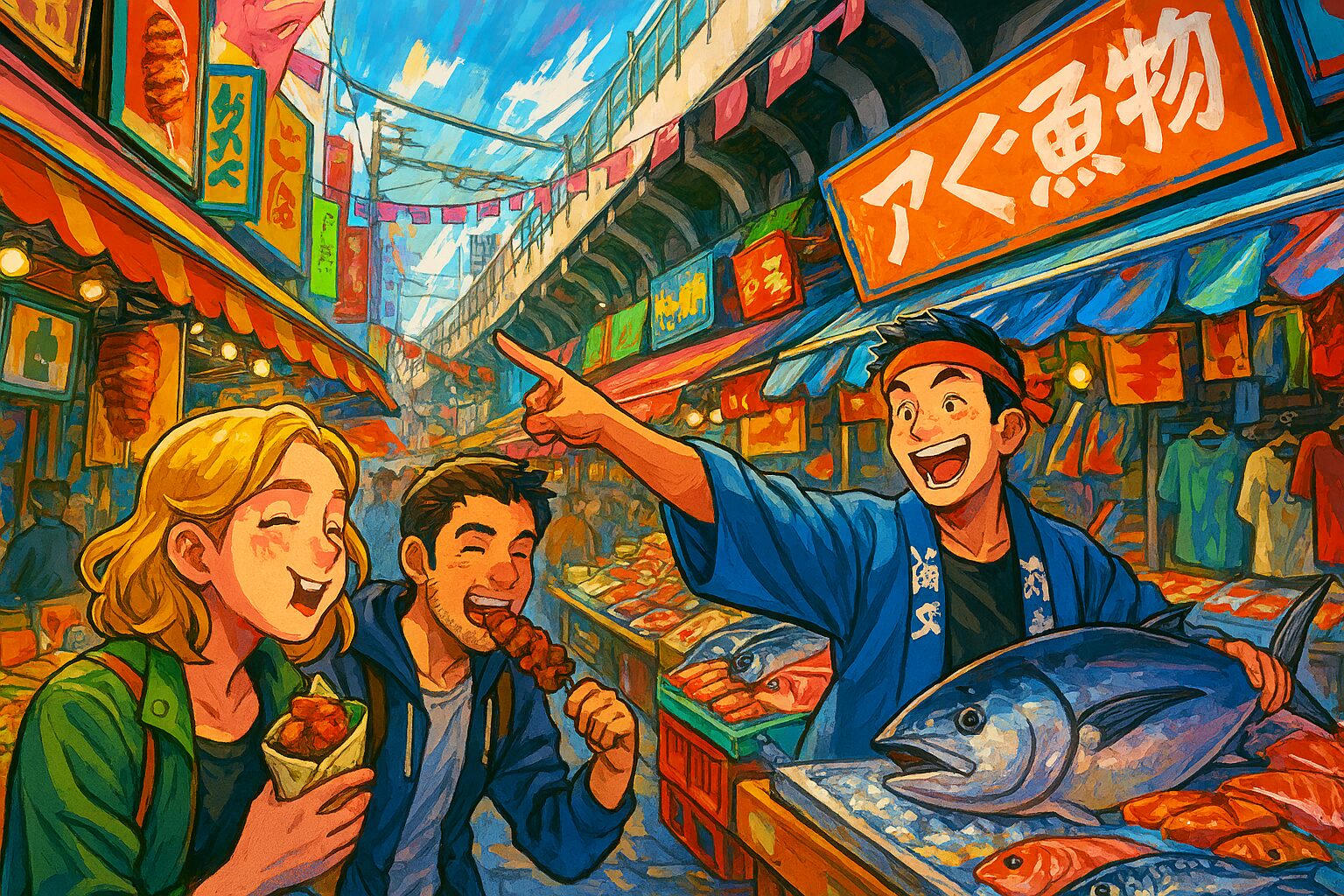Today, October 11th, is not a specific public holiday, but on this day, let’s shine a special light on the history of “Ameya Yokocho,” or simply “Ameyoko,” the massive, vibrant shopping street nestled between Ueno and Okachimachi in Tokyo.
The roots of Ameyoko’s hustle and bustle trace back to the tumultuous period following the end of World War II. This area originated as a “Yamishi (Black Market),” born outside legal regulations due to the severe post-war material shortages. The Black Market was a lifeline for people at the time, providing everything from daily necessities to luxury items. This chaotic vitality is the very source of modern Ameyoko’s energy.
While there is no clear record specifically tying October 11th to Ameyoko, it is certain that during the street’s formative years, in the late 1940s to early 1950s, many stalls and street vendors formally transitioned into a shopping district through the process of “Black Market Reorganization and Public Market Formalization.” This structural change created the fixed name and area known today as “Ameyoko.”
The Origin of the Name “Ameyoko”: America or Candy?
There are two main theories regarding the origin of the nickname “Ameyoko”:
- “Ame”rica “Yoko”cho (America Alley Theory): This theory suggests it was named the “American Alley” because large quantities of goods—especially American products—dumped by the occupying forces were circulated here after the war. Items like jeans, chocolate, and gum, which were novel symbols of new culture to the Japanese people at the time, were traded here.
- “Ameya” Yokocho (Candy Store Alley Theory): This theory posits it was named the “Candy Store Alley” because during the post-war shortage, many shops specialized in “Ame (candy),” a precious sweet commodity.
Both theories symbolize Ameyoko’s history, and today, the historical backgrounds of both “America Alley” and “Candy Store Alley” have merged to form the street’s unique and singular identity.
The Key to Understanding Japan’s “Hustle Culture”
The history of Ameyoko is more than just the tale of a shopping street’s birth. It symbolizes “Restoration” and “Japan’s Cultural Adaptability.“
1. Order within Chaos: The Japanese-style Chaos
Ameyoko’s transformation from the post-war “lawless zone” of the Black Market into today’s orderly shopping district embodies the Japanese society’s characteristic power to elevate “Chaos” into “Order.”
While black markets in other countries often faded or led to continuous decline in public safety, Japan’s Ameyoko, through the tough spirit of its merchants and subsequent government authorization, converted into a legitimate business supporting the regional economy. This “coexistence of toughness and discipline” is one of the cultural factors that enabled Japan’s astonishingly rapid post-war recovery.
2. “Bargaining” and “Humanity”: The Flip Side of Japanese Culture
To international readers, Japan might have an image of “perfect service” and “fixed prices.” However, in Ameyoko, especially during the year-end “Tatakiori (Bargaining/Fire Sale)” period, fierce price negotiations take place between merchants and customers.
This is a culture unique to Ameyoko, distinct from Japan’s everyday consumer habits. The human interaction and the vibrant “vocal culture” created through this negotiation offer a glimpse into the wet (passionate, human) side of the Japanese people. Ameyoko is a place where the “passionate and human” energy is condensed—the direct opposite of Japan’s image as “efficient and cool.”
3. A “Melting Pot” of Diversity: A Microcosm of Japanese Food Culture
The sight of all kinds of goods—food, clothing, sundries, cosmetics, and multinational ingredients—jumbled together in Ameyoko reflects the diversity of Japanese food culture itself. The coexistence of sushi and seafood alongside kebabs, Chinese, Korean, and Vietnamese cuisine shows how much Japan has embraced foreign cultures and digested them into its own unique style.
This “mixed-up feeling” is one of the distinct charms of modern Japanese culture, particularly in Tokyo, and it’s a reason why people from all over the world are endlessly drawn to it.
A Question for Our Readers
Has reading this article changed your image of Ameyoko in Tokyo?
If you have the chance to visit Japan, would you want to experience walking through Ameyoko’s vibrant alleys, hearing the vigorous voices of the seafood merchants, and enjoying diverse international street food? What would be the first thing you’d want to buy?
Recommended Valid Links
- Ameya Yokocho Official Site
https://www.ameyoko.net/ - Tokyo Tourist Information Center Ueno
https://www.gotokyo.org/en/spot/132/index.html
🇯🇵 What’s Today’s Special Day Series: 10月11日 – 「アメ横」誕生の奇跡とその文化
本日、10月11日は特定の公的な記念日ではありませんが、この時期、東京の活気あふれる上野(Ueno)と御徒町(Okachimachi)の間に位置する巨大な商店街「アメ横(Ameya Yokocho)」に、特別な歴史の光を当ててみましょう。
アメ横の賑わいのルーツは、第二次世界大戦終結後の混乱期にあります。この地は、戦後の物資不足の中、法的な規制の外で生まれた「闇市(Yamishi – Black Market)」がその起源です。闇市は、生活必需品から贅沢品まで、あらゆるものが手に入る、当時の人々にとっての生命線でした。この混沌とした活力が、現代のアメ横のエネルギーの源となっています。
特に、10月11日がアメ横と深く結びつく明確な記録はありませんが、アメ横の形成期である1940年代後半から1950年代初頭の「闇市の整理と公設市場化」のプロセスにおいて、この季節、多くの屋台や露天商が正式に商店街へと姿を変えていったことは間違いありません。この構造的な変化が、現在の「アメ横」という固定化された名称とエリアを作り上げました。
「アメ横」の名前の由来:アメリカか? 飴か?
「アメ横」という愛称の由来には、主に二つの説があります。
- 「アメ」リカの「横」丁 (アメリカ横丁説):終戦後、進駐軍払い下げの品々、特にアメリカ製品が大量に流通していたことから、「アメリカ製品の横丁」という意味で呼ばれるようになったという説です。ジーンズやチョコレート、ガムなど、当時の日本人にとっては珍しい、新しい文化の象徴がここで取引されました。
- 「飴」を売る店が多かった「横」丁 (飴屋横丁説):戦後の物資不足の中、貴重な甘味であった「飴」を専門に扱う店が軒を連ねていたことから、「飴屋横丁」と呼ばれたという説です。
どちらの説もアメ横の歴史を象徴していますが、現在では「アメリカ横丁」と「飴屋横丁」の両方の歴史的背景が融合し、この地の唯一無二の個性を形作っています。
日本の「雑多なエネルギー」を読み解く鍵
アメ横の歴史は、単なる商店街の誕生譚ではありません。それは、「復興」と「日本の文化的な適応力」を象徴しています。
1. 混沌の中の秩序:日本型カオス
戦後の闇市という「無法地帯」から、現代の整然とした商店街へと変化したアメ横の姿は、日本社会の特徴である「混沌(Chaos)」を「秩序(Order)」へと昇華させる力を体現しています。
他の国々の闇市が、そのまま衰退したり、治安の悪化を招いたりしたのに対し、日本のアメ横は、商人たちのタフな精神と、行政の指導による公認化を経て、地域経済を支える合法的なビジネスへと転換しました。この「タフさと規律の両立」こそが、日本が戦後驚異的なスピードで復興を遂げた文化的要因の一つです。
2. 「値切り」と「人間味」:日本文化の裏側
海外の読者にとって、日本は「サービスは完璧」「値段は定価」というイメージが強いかもしれません。しかし、アメ横では、特に年末の「叩き売り(Tatakiori – Bargaining/Fire Sale)」の時期に、商人との激しい価格交渉(値切り)が繰り広げられます。
これは、日本の日常の消費文化とは一線を画す、アメ横特有の文化です。この交渉を通じて生まれる、店員と客との間の人間的なやり取りや、活気ある「声」の文化は、日本人が持つウェット(情熱的、人間的)な一面を垣間見せてくれます。アメ横は、日本の「効率的でクール」なイメージの裏側にある、「情熱的で人間臭い」エネルギーが凝縮された場所なのです。
3. 「ごちゃまぜ」の多様性:日本の食文化の縮図
食品、衣料品、雑貨、化粧品、そして多国籍な食材まで、あらゆるものが雑然と並ぶアメ横の様子は、日本の食文化の多様性そのものを表しています。寿司や海鮮物だけではなく、ケバブ、中華、韓国料理、ベトナム料理などが混在している光景は、日本がどれほど異文化を受け入れ、それを独自のスタイルで消化してきたかを示しています。
この「ごちゃまぜ感」こそが、現代の日本文化、特に東京の持つ魅力の一つであり、世界中の人々を惹きつけてやまない理由でしょう。
読者への問いかけ
この記事を読んで、東京のアメ横のイメージは変わりましたか?
もしあなたが日本を訪れる機会があれば、アメ横の活気ある路地を歩き、魚介類を売る商人の威勢のいい声を聞き、立ち食いの屋台で異文化のフードを楽しむ。そんな体験をしてみたいと思いますか?
有効な関連リンク集
- 上野アメ横商店街公式サイト (Ameya Yokocho Official Site)
https://www.ameyoko.net/ - 東京観光情報センター 上野 (Tokyo Tourist Information Center Ueno)
https://www.gotokyo.org/en/spot/132/index.html



コメント